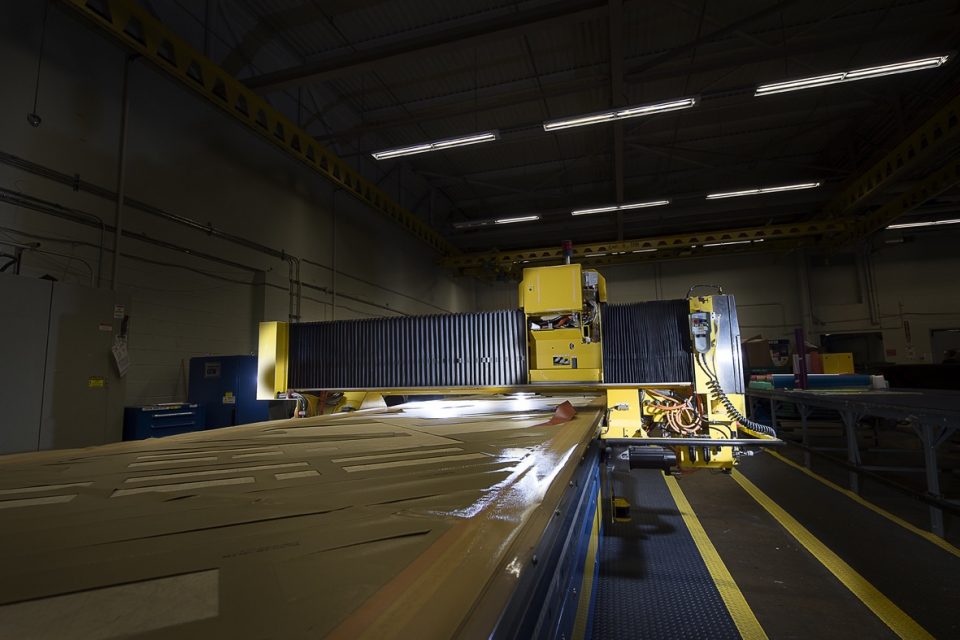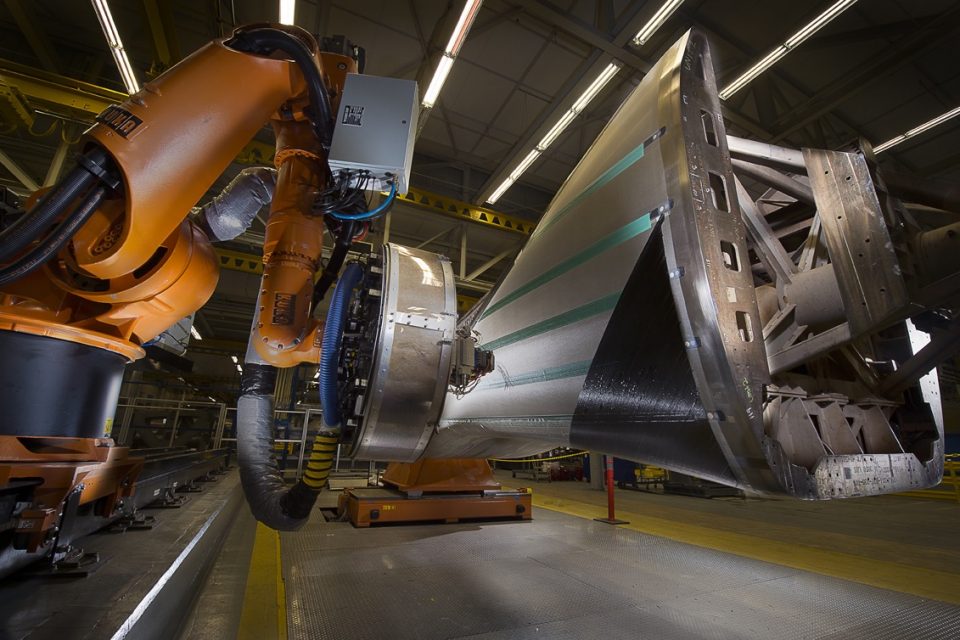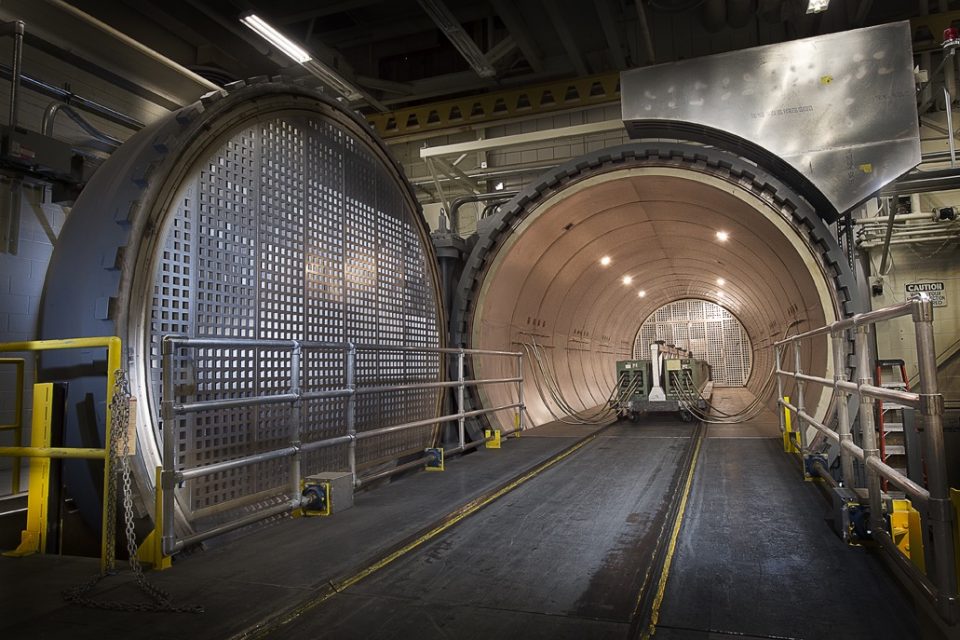2015-05-28 By Robbin Laird
Arriving at Boeing’s Philadelphia site, one is presented with a large industrial park where Boeing produces the venerable Chinook and a significant part of the world’s only military tiltrotor aircraft, the Osprey. And on the Boeing line, CV-22s as well as MV-22s are produced with the final product coming out from the partner plant in Texas run by Bell.
The graphic below shows the division of labor between the two companies with the section in blue highlighting what one can see produced at the plant in Philadelphia.
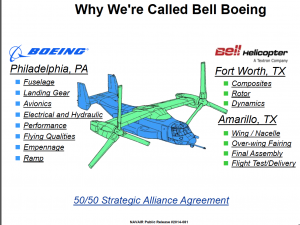
The plane has matured in the past few years, and it is making combat history.
And as it does so, allies are looking to buy the aircraft.
In addition, the US Navy has decided to replace its venerable C-2 or Greyhound with the V-22 to play the COD or Carrier On-board delivery role.
The core competence of the MV-22 as a revolutionary combat assault asset or the CV-22 as a special forces asset is being joined by evolving multi-mission capabilities for the aircraft as well, first up being an air refueling capability.
What is clear from visiting the plant is that the manufacturing process has matured and along with it the upgrade process as well.
The Osprey has reached a critical juncture whereby it can become a global product, if the supply chain catches up with the production process.
In this piece, the focus will be upon the maturing of the production process as seen from visiting the composite center of excellence as well as the final assembly line at the plant.
The Composite Production Facility: A Dynamic Working Relationship between Humans and Robots
Composite technology and the ability to manufacture key parts via composite materials is a key reason for the viability of the aircraft.
Producing composite parts is a key part of the production process.
Given that composite raw material is stored and shipped frozen, the part production process is time-sensitive as the clock starts ticking from the time the material begins to thaw, until it is ultimately cured, finished, and moved to the assembly process.
It is a very complex choreography to get this process right.
Tom Jablonski, head of the Composites Center of Excellence (CCOE), provided the tour of the facility and insights with regard to the production process.
His background is in both civilian and military composites and obviously this is an area where cross cutting innovations in the military and civilian sectors help one another.
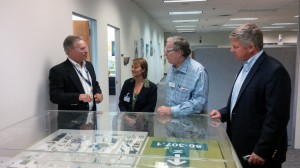
Question: How would you describe the choreography necessary for the production process?
Jablonski: “That is a good term to describe the process.
We start with raw material receipt. We have a large freezer outside of the center to store bulk raw material received from the supply chain.
We then stage material about to be introduced into the manufacturing process in a smaller freezer inside the center.
When we are ready to start the process, that raw material is issued to one of several machines for cut or automated lay-up.
We have four automated raw material cutters. This material is cut into “kits” and then paired with the corresponding tool. We have all sorts of Bond Assembly Jigs (BAJs) in addition to molds, caul plates, and other consumable tooling that aid in developing and maintaining the part size and shape.
Our Industrial Engineering team controls order release, the start of the manufacturing process. These load decisions are based on tool availability, takt time of the manufacturing process, and assembly flow. Right now, the V-22 Assembly process is building at a pace that supports our customer funding and demand.”
Jablonski added that increasing the scope of work by including some minor sub-assembly processes enables them to deliver a more finished part to the production process as well.
And robots have entered the process as a key part of improving the process.
A trajectory was evident from visiting the facility whereby in a very short period of time – five years – large automated machines are being replaced by commercial robotic machines imported from abroad but with unique, Boeing-developed components to facilitate the actual manufacturing process.
This has not only reduced man-hours in the process, it has improved cost as well.
With the larger automated machines, maintenance and machine downtime was significant.
With the newer robots, these machines are more reliable.
Large, heavy tools are no longer needed to move; the robot moves about the tool, reducing the wear and tear on the machine and hence cost.
Jablonski: “From a technology perspective, a lot of the early automated fiber placement technology was very specific, very rudimentary, and not overly efficient.
We had one of the first fiber placement machines in industry, to the best of my knowledge, installed in the early ‘90s.
This machine has since been replaced by a robot.
The robot itself is off-the-shelf, so we didn’t develop robotic technology because there was no need.
We developed the head of this robot to handle the high tolerance manufacturing of these composite parts.
This head sits on the end of a robot that another company had already developed and perfected.
Part of the ramp-up in production was enabled by this technology.
It gave us the ability to achieve certain material placement and steering that was not achievable by hand.
This in turn gave us a more efficient solution to manufacture complex composite parts and assemblies that are ultimately installed on the airplane.
It helped us remain on the cutting edge of technology, highlighting that robotic technology with respect to fiber placement is far more scientific than some of the older machines still on the floor.
Older, by the way, was brand new five-plus years ago. So state-of-the-art technology five years ago is already less efficient than the current fiber placement options.”
The plant builds hundreds of parts for the V-22.
Five parts are built by machine – two drag angles (right and left), two side skins (right and left) and a large, monolithic aft section.
The balance of these parts are laid-up by hand.
The automated trim cell section of the composite center of excellence has several interesting machines as well.
Jablonski: “A consideration for a composite fabricator when trimming a part is how to hold it still.
How do you hold a very large part that you’d like to trim the periphery of?
As part of the Trim Cell itself, we have another machine, a universal holding fixture (UHF), and it’s essentially a table.
It has an elaborate electronic control system that determines the coordinates of the part in space, and adjusts the height of several dozen “pogos” to match the contour of the part, and then it applies suction to pull that part against the pogos, holding the part still so the machine can do its thing.”
The Final Assembly Line
Jim Curren, senior manager of Operations, provided the tour of the FAL and from the tour, it was clear that the approach implemented with regard to the FAL at Boeing’s Philadelphia site has two clear advantages.
First, there is a single assembly line where by the MV-22 and CV-22 are built.
The modifications for the CV-22 are done at the appropriate station in the line and with the workers who do those mods adjacent to that work station in the production flow.
This means that when the Navy V-22 is built the same assembly line can be built with the modifications of that aircraft done within the established work flow.
Second, the initial workstation is where the electronics are matted to the key sections and then those sections are connected together prior to moving to the next workstation.
This means that the numbers of workers necessary in the second workstation can be reduced to enhance efficiency of production as well.
Curren highlighted the growing role of robots on the FAL as well.
“We keep looking for better ways of building the aircraft in the eyes of affordability.
In that process, robots are getting a lot of attention, more so now than ever.
They’ve come a long way, so we’re three years into implementing or incorporating a robot into our structures build process.”
In short, the investments in the machinery to provide for high tolerance manufacturing and the skill of the workers in operating the machinery and working the production process along with effective management are key drivers in shaping the maturity of the production process on display at Boeing’s Philadelphia site.
Editor’s Note: The CV-22 is different from the MV-22 in the following manner, according to NAVAIR:
“The CV-22 is equipped with a unique suite of integrated threat countermeasures, terrain-following radar and other advanced avionics systems that allow it to operate at low altitude in adverse weather conditions and medium- to high-threat environments.”
This is the second in a six part series on the Osprey, its maturation and the next phase of its development.
The visit to the Boeing facility was done by Robbin Laird and Murielle Delaporte, with Delaporte’s pieces to appear in the French press later this summer.
Earlier pieces in the series:
Osprey at the Eight-Year Mark: Preparing for the Next Phase
The photos in the slideshow provide a chance to look at some of the machines discussed by Jablonski.



